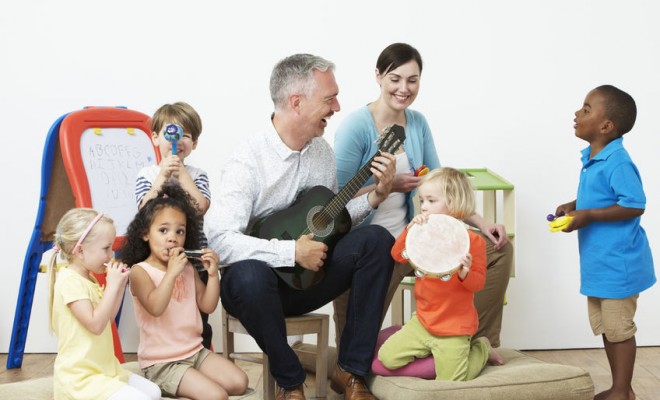
Childcare Activities
Simple Classroom Guitar: 20 Childrens Songs with Just Two Chords
This simple classroom guitar guide is aimed at those who do ‘a bit’ (or a lot) on guitar and are curious about how you might best use it in an early years setting. There are real advantages to using an acoustic guitar with young children – it’s warm, welcoming, inclusive, and never too loud and overbearing. You can play while sat among the group, sitting out front, and even walking about if you’re a more confident player.
Below is a list of 20 familiar nursery rhymes/ children’s songs which can be accompanied with just two chords. In addition, there’s a suggestion about the ‘key’ of a song (and therefore which pair of chords will apply).
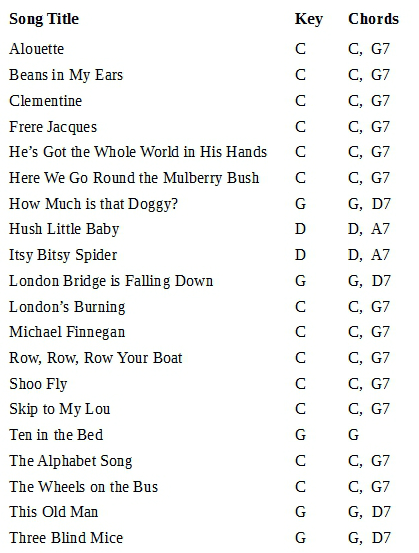
A word about chords
Use basic strums which will make it easier for the class to hear the words when you sing. Playing chords well requires patience and practice. The three pairs of chords shown in the chart below are the easier ones to attempt first.
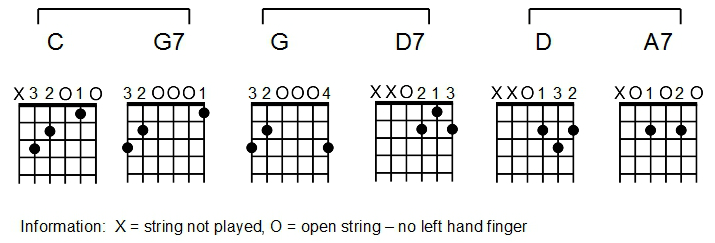
The numbers refer to the left-hand fingers you should use (e.g. 1 = the index finger, 4 = your ‘little’ finger). A zero means that the string indicated should be allowed to ring out without any left-hand finger on that string (= an ‘open’ string). And those strings with an ‘x’ above must not be sounded in the chord at all.
Putting it together
One very easy song is ‘Ten in the bed’ – which only requires one G chord to be played all through. Those who find even one chord tough could just strum the four highest (thinnest) strings – which means you can then get away with holding down only one left-hand finger!
Practice a basic strum pattern as shown below – but use your own pattern if you prefer (and know what you’re doing). Always keep the guitar accompaniment fairly soft, just shadowing and supporting the voices:

Right from the start, you should aim to bring the song to life.
Please don’t settle for ‘performing’ a song – tell the story, and make it fun for everybody by adding some “extras”. This also allows the singing and music-making to be only one part of a broader experience. That also takes pressure off you and adds interest for everybody, making the whole thing more inclusive and interesting.
Sign Up to Receive this 20-Part Activity Email Series
What you can do is only ever limited by your imagination, but some options might be:
- Use two adult singers who swap alternate verses (like news presenters?). You could then ‘double’ the voices in places to create greater intensity (e.g. on “Roll over”).
- Make some visuals – e.g. large number cards (1-10) which helpers hold up at the appropriate verse. When the kids ‘know’ the song, persuade your colleagues to display one or two of their numbers upside down to see who notices the ‘mistake’ – which could also be a smart way into getting some children to do the job as well/instead.
- Get groups of children to ‘roll over’ whenever they hear that part of the song. You could even “perform” the song with 10, 9, 8 … live kids, puppets (or soft toys) if you wish.
- For variety, you could also use an (African) ‘call and response’ technique. Here, you would sing the song alone, with the children joining in on the repeated ‘roll over’. (It’s also quite a good way to perform the song whilst your little ones are getting to know it). And when they do know the song well, you could leave them to sing those words on their own – which enhances the feeling of making music together.
- One confident child could become the ‘little one’ who says ‘roll over’ on cue.
- Bring the sound level right down to a whisper at the end, and finish with:
… and the little one said … Good night … Good night - Get the children to pretend to fall asleep after the final round – with a reward for the most convincing sleepers. [ So this song could soon become a tool to calm down your kids.]
- This is a counting song, so you could discuss ‘counting sheep’ to get to sleep too. (So how do sheep get to sleep? … And do they snore?)
- Link to rhymes/songs about sleep: ‘Rock a bye baby’ (a song which is 240 years old!); ‘Frere Jacques’ (how they get to sleep in France) etc.
Instruments you could use:
- This song uses just four notes all through, so adding an adult playing the melody on recorder, flute, keyboard, glockenspiel etc. is a real possibility.
- Light percussion (or hand-claps) could be used with same rhythm as guitar (but don’t drown the singing). Soft hand clapping can be done by tapping your palm with the fingers of the other hand (it’s a trick flamenco performers use).
- Adding another very light ‘tick-tock’ rhythm would also expand the effect.
- Those with the know-how could tune a ukulele to an ‘open-string’ G chord (notes G,B,D, B going across from thick to thin strings). Your kids can then strum along without holding down any notes at all – and hey presto, you’ve got a band!
- If you have any individual glockenspiel note bars (and if you’re feeling very, very brave) give one note bar each (which must be a G, B or D) and a beater to some children and ask them to ‘play along’. Because it’s a one-chord song, they just cannot play a wrong note when set up like this.
- Make yourself a DIY set of ankle bells on a string which you tie around one ankle. When you tap your foot in time to your chords, this creates a clear beat for the children to follow. Perhaps later, when they’ve got the idea of the song, you could get some of them to do the same. (Be aware your colleagues will think you’ve become a Morris Dancer.)
Working alongside one or more adults expands the possibilities, and makes performing the song even easier (just rehearse a few times first, so you all know what you’re doing). Select the ideas that suit your style and your children.
For adults, the aim should always be to do simple things well so you can focus on putting the song across and helping to make it all really meaningful for the kids. Having fun is mandatory, all the rest is optional and limited only by your enthusiasm!
Read more about the benefits of music therapy in early years.
Online resource:
Below is one of many sites where you can find words and chords for popular songs such as those listed above. More importantly, this information will provide you with a musical map detailing the points at which your chords should change.
Childrens’ Songs & Rhymes with Easy Chords http://www.traditionalmusic.co.uk/childrens-songs-chords/


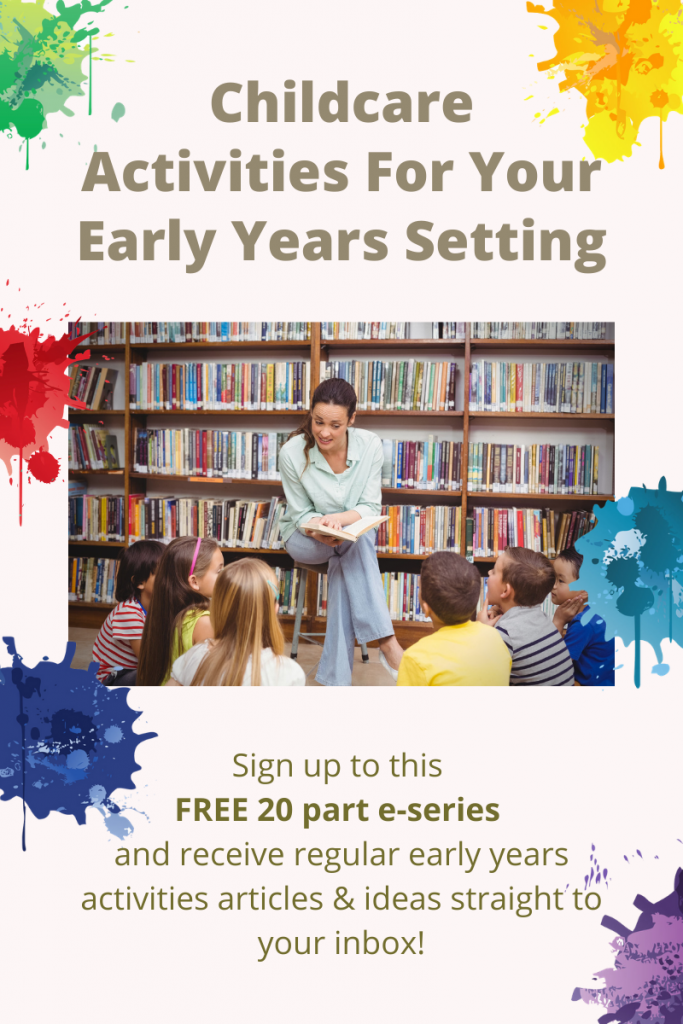
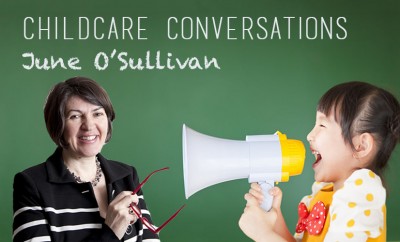



1 Comment
You must be logged in to post a comment Login